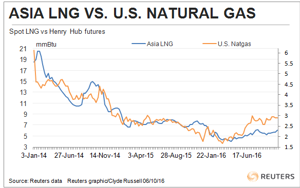LNG prices enjoying seasonal gains, but may be short-lived
(Clyde Russell is a columnist for Reuters. The opinions expressed are his own.)
(Reuters) It's around about now that LNG spot prices usually start rising in Asia ahead of winter demand, and this year looks set to hold to the pattern, although any relief for producers is likely to be short-lived.
While the LNG market is heading for structural oversupply next year, and for several years thereafter, there are several short-term factors that have been supporting prices, and should continue to do so for a little while.
Asian spot LNG prices have been trending higher in recent months since hitting $4/MMBtu in April, the lowest since assessments started in 2010.
The price rose to $6.10/MMBtu in the week ended September 30, up 52.5% from the April low, but still less than a third of the all-time peak of $20.50 hit in February 2014.
Even though LNG prices have been in a steep downtrend since the record high more than 2-1/2 years ago, they still exhibit seasonal behavior, rallying ahead of the northern summer and winter and slipping back during the spring and autumn.
However, the size of these calendar-led rallies have been diminishing in recent years as new LNG supply overwhelms the seasonal demand shifts.
Nine liquefaction trains are expected to start up in 2016, adding 35 MMtpy of LNG to the market, with the additional capacity coming largely from new plants in Australia and the US. Australia is poised to become the world's largest producer of LNG, drawing ahead of Qatar, as it completes the last of eight new projects.
Between 2016 and 2020, global LNG capacity is expected to rise by about 50% to around 370 MMtpy, and it is this expected run-up in supply that has been such a drag on prices.
In 2014, spot LNG in Asia surged almost 43% between late July and the peak summer demand in September, but the winter rally was far weaker, with prices gaining only 6.3% between November and January of 2015.
The next year, in 2015, prices rallied 10.9% between late June and late July, and by 18.1% between early October and late November.
This year, the rise in prices ahead of winter has been 15% since the recent low in early September to last week's assessment, and there appears to be room for further gains.
One of the main supporting factors has been a tightening of the US natural gas market.
Up until 2014, LNG prices in Asia had very little correlation with US natural gas futures, but with the advent of US LNG exports, global gas prices started to converge in anticipation of a more integrated market.
Given that US LNG shipments have now commenced, the country is in some ways acting as the marginal supplier, meaning that traditional producers supplying the major demand centers in Asia have had to match their prices to the cost of cargoes from the US.
But US natural gas prices are starting to surge as demand gains the upper hand over supply and in anticipation of a colder than usual winter in North America.
Futures ended at $3.021/MMBtu on Wednesday, up 84% since a 21-year closing low of $1.639 on March 3.
While shipping data compiled by Thomson Reuters Supply Chain and Commodity Forecasts shows only one cargo of LNG being shipped from the US Gulf to North Asia this year, the mere possibility of the US flows to Asia kept spot prices tied to US natural gas prices.
With the strong rally in US natural gas prices, it's likely that LNG from the new producers in the Gulf of Mexico won't be competitive in Asia, thus allowing the region's spot prices to rise.
LNG has also likely been boosted by higher prices for crude, which will have dragged up the price of the super-chilled fuel supplied under long-term contracts linked to oil.
A rally of almost 70% this year in Australian benchmark thermal coal is making LNG more attractive as well relative to its main competitor in the power generation sector.
While coal remains cheaper, its advantage has eroded, and utilities may be tempted to use more cleaner-burning LNG over the northern winter, especially in countries like China where pollution is increasingly a political factor.
On the supply front, the market has been tightened by maintenance at the Gladstone LNG plant in Australia's Queensland state and at the Sabine Pass facility in the US.
But both these plants should be back in production by end-October, and Angola is also now offering cargoes after its plant returned to operation recently, suggesting that tightness in the market should ease by November.
This means it will take a colder-than-usual winter to extend the rally in Asia's spot LNG prices beyond the next few weeks.
By Clyde Russell; Editing by Tom Hogue







Comments